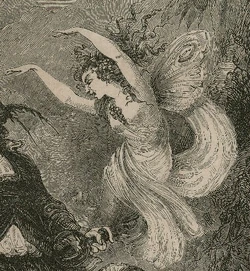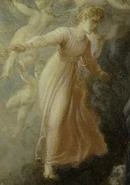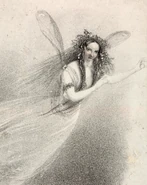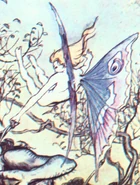| Ariel | |
|---|---|
 | |
|
Real Name |
Ariel |
|
First Appearance |
The Tempest (1610) |
|
Created by |
William Shakespeare |
Origin[]
Ariel is an elemental air spirit who inhabited the island where the wizard Prospero was exiled in William Shakespeare's The Tempest.
Biography[]
Prior to Prospero's arrival, Ariel was enslaved by the evil witch Sycorax, who had been banished to the island from her native Algiers. As he refused to follow her orders, Sycorax punished him by trapping him within the bark of a pine tree for twelve years, during which interval she died and the island was inherited by her son: an inhuman creature named Caliban. Ariel's imprisonment was painful to him, as evidenced by his howls of despair which would frighten the animals of the island.
When Prospero arrived along with his daughter Miranda, he freed Ariel from his torment, and the spirit offered his gratitude by becoming his loyal servant. As the years passed, though, Ariel craved for his liberty. Unlike Caliban, however, he remained diligent, obedient and respectful towards his master.
Being an air spirit, Ariel is capable of several feats of magic. He notably created the titular tempest to capture the ship carrying Prospero's enemies while at the same time allowing them to get to the island safely. He can also shape-shift, become selectively invisible (so that only Prospero can see him), cast powerful illusions and put people into a sort of trance.
While Prospero originally intended to get revenge on those who wronged him - particularly his brother Antonio, who usurped him of his position as Duke of Milan and sentenced him and Miranda to their exile - it was Ariel's compassion for them that caused him to change his mind, realizing that if a simple air sprite was capable of forgiving, he as a human being should be as well. As he gained back his position and returned to Milan, Prospero finally granted Ariel his freedom.
Notes[]
- Ariel's gender is somewhat ambiguous in the play. In his introduction he refers to himself in the third person using the male pronoun. However, he assumes unambiguously female forms throughout the play, those being: a sea nymph, a harpy and the goddess Ceres. Being a nature spirit, it's possible that the character was intended to be viewed as genderless. From the 17th to early 20th century it was commonplace to have Ariel portrayed on stage by an actress.



